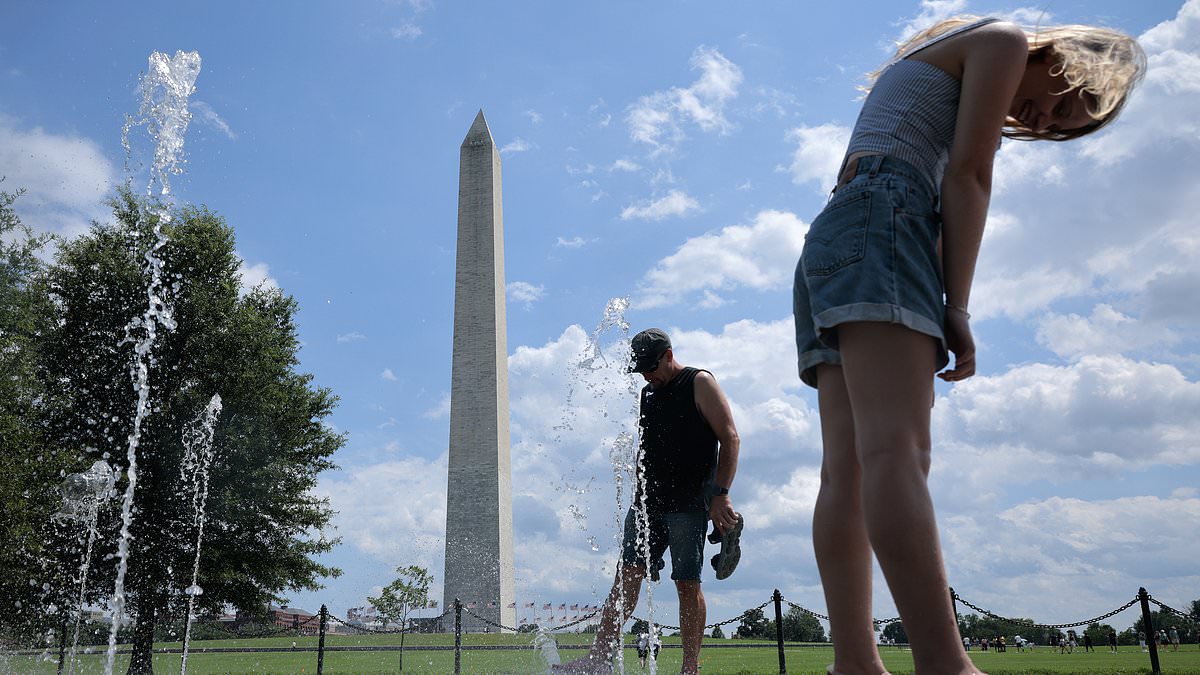A bulge in the jet stream across American skies is set to trigger an extreme heat dome this week – bringing triple-figure temperatures to large swathes of the country.
Nearly 85 million Americans, from South Dakota to Texas and North Carolina to Florida, are already experiencing the extreme heat warnings.
But the sweltering conditions are expected to intensify this week – causing temperatures to swell into the high 90s and surpass 100s in some areas.
Dallas and Kansas City are among the densely-populated urban areas where the heat index is expected to go above 100F, triggering a drought due to the lack of rainfall.
AccuWeather Senior Meteorologist Chad Merrill said: ‘This has the look of a long-lasting heat wave with limited rainfall.
‘Drought will expand through the central Plains by mid-August and worsen in Kansas and Nebraska, where there are already pockets of moderate to extreme drought.’
The heat wave could continue until the last weekend of July in the Plains and South, before the rising temperatures move westward towards the Rockies.
A heat dome is a high-pressure atmospheric system that causes warm air to be pushed to the Earth’s surface – often becoming trapped for longer periods of time.

Nearly 85 million Americans, from South Dakota to Texas and North Carolina to Florida , are already experiencing the extreme heat warnings

While the south is hit by the intense heat, the Northeast is experiencing low humidity and cooler temperatures – but a so-called ‘bubble’ of the heat dome is expected to move towards the east in the coming weeks. (Pictured: Tourists cool off in Washington D.C.)
While the south is hit by the intense heat, the Northeast is experiencing low humidity and cooler temperatures – but a so-called ‘bubble’ of the heat dome is expected to move towards the east in the coming weeks.
Washington DC, where the heat is currently in the 50s, will rise to almost 100F after July 25 – as will Philadelphia and New York City.
On Thursday and Friday, Detroit, Michigan will reach into the 90s and upwards.
‘The late-week scorcher heading into the East will be a quick whiplash,’ Merrill said.
The meteorologist added that although the heat wave is expected to be intense, Merrill said ‘this one won’t last nearly as long’ as the spike in temperatures that happened in late-June.
Similar to last month’s heat wave, a cool front is expected to come over the weekend. It will arrive from northeast and north, as opposed to from the west and northwest, according to AccuWeather.

Dallas and Kansas City are among the densely-populated urban areas where the heat index is expected to go above 100F, causing a drought due to the lack of rainfall
Because of the hot and humid weather, thunderstorms are expected to make landfall.
The storms, which are expected to be severe, will stem from less humid air colliding with hot and humid air.
A jet stream is a narrow string of strong winds between the US and Canada that typically slows down during the summer months and becomes more regular in the winter.
The stream itself affects long-term weather trends and daily forecasts.
Jet streams are located in the upper troposphere – about 30,000ft above the earth’s surface.
In addition to heat triggering damaging storms, it can also pose a threat to people’s health.

Philadelphia and New York City will see temperatures rise to almost 100F after July 25. (Pictured: A person walking their dog in New York as water shoots out of a fire hydrant)
With the high humidity and extreme heat, it can become dangerous for some and increase the likelihood for heat-related illnesses.
People are urged to stay inside when they can, use air conditioning, and to drink plenty of water to cool down.
During the intense heat wave last month, 472 people in Maryland needed medical assistance due to the high temperatures, which reached 110F in some places, CBS News reported.
